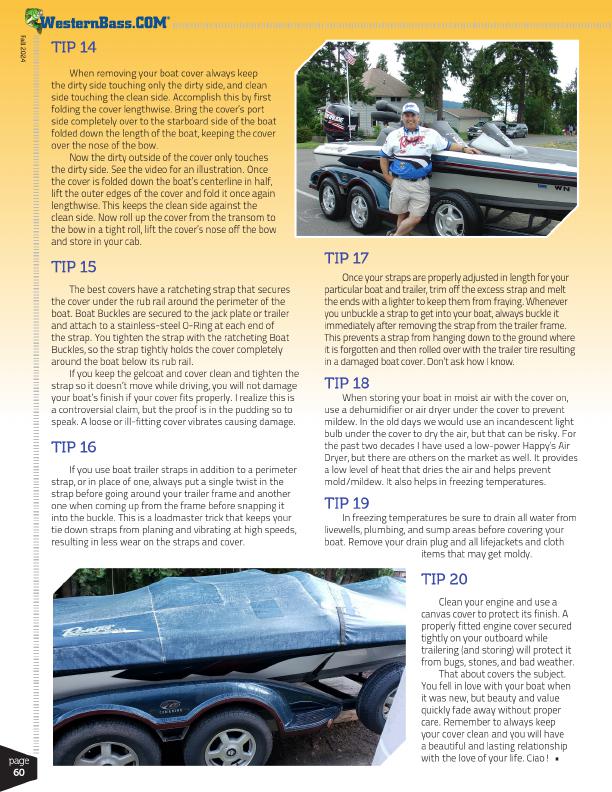
Fall 2024
®
TIP 14
When removing your boat cover always keep the dirty side touching only the dirty side, and clean side touching the clean side. Accomplish this by first folding the cover lengthwise. Bring the cover’s port side completely over to the starboard side of the boat folded down the length of the boat, keeping the cover over the nose of the bow.
Now the dirty outside of the cover only touches the dirty side. See the video for an illustration. Once the cover is folded down the boat’s centerline in half, lift the outer edges of the cover and fold it once again lengthwise. This keeps the clean side against the clean side. Now roll up the cover from the transom to the bow in a tight roll, lift the cover’s nose off the bow and store in your cab.
TIP 15
The best covers have a ratcheting strap that secures the cover under the rub rail around the perimeter of the boat. Boat Buckles are secured to the jack plate or trailer and attach to a stainless-steel O-Ring at each end of the strap. You tighten the strap with the ratcheting Boat Buckles, so the strap tightly holds the cover completely around the boat below its rub rail.
If you keep the gelcoat and cover clean and tighten the strap so it doesn’t move while driving, you will not damage your boat’s finish if your cover fits properly. I realize this is a controversial claim, but the proof is in the pudding so to speak. A loose or ill-fitting cover vibrates causing damage.
TIP 16
If you use boat trailer straps in addition to a perimeter strap, or in place of one, always put a single twist in the strap before going around your trailer frame and another one when coming up from the frame before snapping it into the buckle. This is a loadmaster trick that keeps your tie down straps from planing and vibrating at high speeds, resulting in less wear on the straps and cover.
page 60
TIP 17
Once your straps are properly adjusted in length for your particular boat and trailer, trim off the excess strap and melt the ends with a lighter to keep them from fraying. Whenever you unbuckle a strap to get into your boat, always buckle it immediately after removing the strap from the trailer frame. This prevents a strap from hanging down to the ground where it is forgotten and then rolled over with the trailer tire resulting in a damaged boat cover. Don’t ask how I know.
TIP 18
When storing your boat in moist air with the cover on, use a dehumidifier or air dryer under the cover to prevent mildew. In the old days we would use an incandescent light bulb under the cover to dry the air, but that can be risky. For the past two decades I have used a low-power Happy’s Air Dryer, but there are others on the market as well. It provides a low level of heat that dries the air and helps prevent mold/mildew. It also helps in freezing temperatures.
TIP 19
In freezing temperatures be sure to drain all water from livewells, plumbing, and sump areas before covering your boat. Remove your drain plug and all lifejackets and cloth
items that may get moldy.
TIP 20
Clean your engine and use a canvas cover to protect its finish. A properly fitted engine cover secured tightly on your outboard while trailering (and storing) will protect it from bugs, stones, and bad weather.
That about covers the subject. You fell in love with your boat when it was new, but beauty and value quickly fade away without proper care. Remember to always keep your cover clean and you will have a beautiful and lasting relationship with the love of your life. Ciao! •